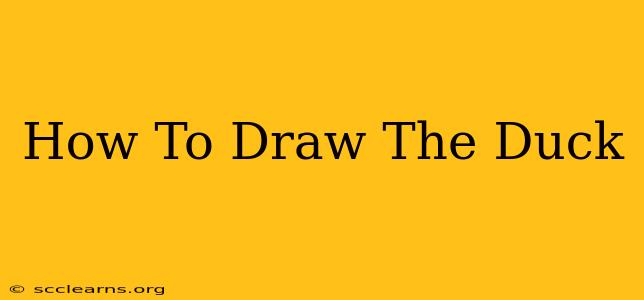So you want to learn how to draw a duck? Fantastic! Ducks are charming creatures, and drawing them can be a fun and rewarding experience, regardless of your skill level. This guide will walk you through a simple step-by-step process, perfect for beginners. Let's get quacking!
Getting Started: What You'll Need
Before we begin our artistic journey, gather your materials. You'll need:
- Paper: Any kind of paper will do, but drawing paper or a sketchbook is ideal.
- Pencil: A standard #2 pencil is perfect for sketching. You can also use a mechanical pencil.
- Eraser: A good eraser is essential for correcting mistakes.
- Optional: Colored pencils, crayons, or markers to add some vibrant color to your duck once you're happy with the sketch.
Step-by-Step Duck Drawing Instructions
Let's get started with drawing your own adorable duck!
Step 1: Drawing the Duck's Body
Begin by drawing a slightly elongated oval. This will form the main body of your duck. Don't worry about making it perfect; it's just a guide.
Step 2: Adding the Duck's Head
Attach a smaller circle to one end of the oval. This will be the duck's head. The circle should slightly overlap the oval.
Step 3: The Duck's Beak
Draw a triangle shape at the bottom of the circle for the beak. Make the bottom of the triangle slightly curved. You can add a small line in the center to split the beak into two parts.
Step 4: Defining the Duck's Eye
Add a small, dark circle to the side of the head for the eye.
Step 5: Drawing the Duck's Feet
Under the oval body, draw two small, webbed feet. These can be simplified as two short triangles, each with three little lines extending out to represent the webbed toes.
Step 6: The Duck's Tail
At the other end of the oval, draw a small, slightly upward-curving line to represent the tail. It doesn't need to be detailed.
Step 7: Adding Details (Optional)
Now it's time to add some personality to your duck! Consider adding:
- Feathers: Add small, curved lines along the body to suggest feathers.
- Wings: Sketch a simple wing shape on one side of the body.
- More detail to the beak: Add some shading to make it look more three-dimensional.
Step 8: Refine and Erase
Once you're happy with the overall shape, use your eraser to clean up any stray lines or imperfections.
Adding Color (Optional)
Once you've completed your pencil sketch, you can add color using your preferred medium. Consider using different shades to create depth and dimension.
Tips for Drawing Ducks
- Observe real ducks: If possible, study real ducks to get a better understanding of their shapes and features. Photos are also a great resource.
- Don't be afraid to experiment: Try drawing different types of ducks, such as mallards, wood ducks, or even rubber ducks!
- Practice makes perfect: The more you draw, the better you'll become.
Conclusion: Your Duck-tastic Artwork!
Congratulations! You've successfully drawn a duck! Remember, drawing is a process of learning and experimentation. Don't be discouraged if your first attempt isn't perfect. Keep practicing and have fun! Now go forth and create your own flock of adorable duck drawings.

